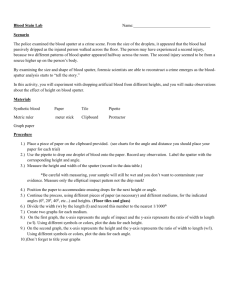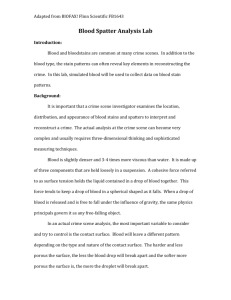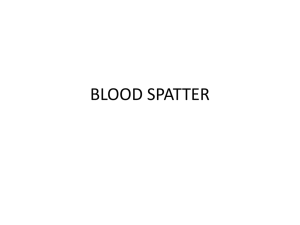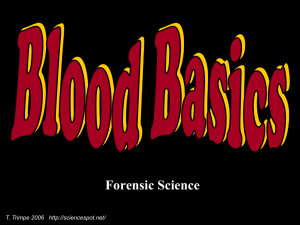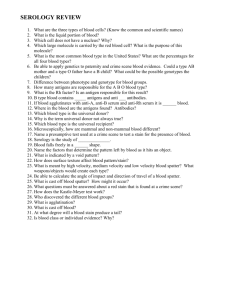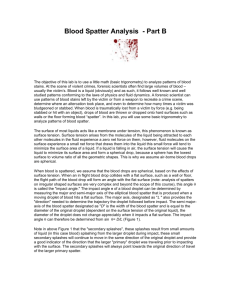Blood Spatter Analysis
advertisement
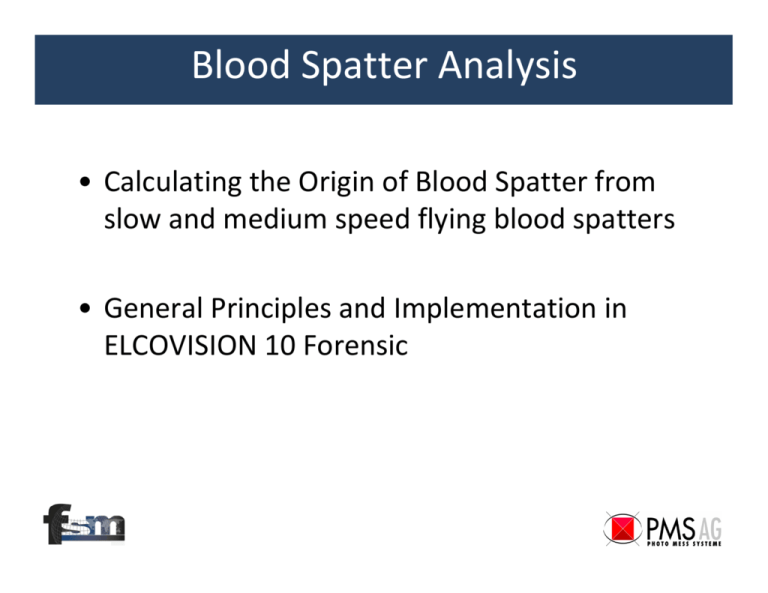
Blood Spatter Analysis • Calculating the Origin of Blood Spatter from slow and medium speed flying blood spatters • General Principles and Implementation in ELCOVISION 10 Forensic What is needed to calculate the origin? • Angle of impact or traveling direction of the blood droplet: Q: Is it possible to calculate this somehow from the shape of the blood spatter? A: Yes. We will see later • The accurate 3D Position and Orientation of the blood spatter in space, e.g. at the wall or other surfaces. • When we know these above Parameters from several blood spatters who belong to the same incident we are able to calculate the origin of the blood spatter by intersecting parables in space: Computation Angle of Impact • Hypothesis: A blood spatter can be described by an ellipse. • The angle of impact is calculated with following equation: Angle = asin( Minor Axis / Major Axis) Falsification of the Previous Hypothesis • We made multiple tests using following experimental setup • Simple paper targets which can be adjusted to various angles between 0° and approx 75° • Drop height: approx 200cm. Start velocity approx 2 m/s, Impact velocity approx 3-5 m/s α=atan(Target / h) = atan(10/200) = atan(0.05) = 2.9° h = 200cm Target: 10*10cm Falsification of the Previous Hypothesis • A frontal photo of the target was taken and digitally rectified: Results • We got the expected results with almost no outliers when the blood spatters were bigger then 3mm • Very small blood spatters ø ≤ 1,5mm shown lots of outliers. We think that the high surface tension of small drops e.g. the high inner pressure of a small droplet prevented them from deforming to an ellipse. Also a rough surface might be responsible for this, because the “roughness” of the surface is in the same order of magnitude as the blood spatter itself. • At ratios minor axis / major axis ≥ | 0.9 | impact angle is also prone to bigger and not systematic errors. At these rations the ellipses appear more and more as circles. Explanation Why We Are Prone to Errors when the Ratio of Minor / Major Axis > |0.9| 90° 75° 60° 45° 30° y= asin(x) d A2 >> dA1 And: -1 ≤ x ≤1 dr -π/2 ≤ y ≤ π/2 (-90°≤ y ≤ 90°) 15° d A1 0° -15° dr -30° -45° -60° -75° -90° Ballistic • To determine the origin of blood spatter, we still need to know how the drops of blood are actually flying. • When a body is flying through the air, it actually follows two movements: – The first movement is a straight movement in the direction in which it originally was accelerated. – The second movement is the continued acceleration in the direction of Earth's center. • The two movements together form the so-called trajectory. In this case, the vacuum, because any moment of friction is neglected for now Straight throw without friction v 5.00 m/s g 9.81 m/s² h 10.00 m t x y without g y with g 0s 0.00 m 10.00 m 10.00 m 1s 5.00 m 10.00 m 5.10 m 2s 10.00 m 10.00 m -9.62 m 3s 15.00 m 10.00 m -34.15 m 100,00 m 0,00 m 1 2 3 4 5 6 7 8 -100,00 m y with g -200,00 m 4s 20.00 m 10.00 m -68.48 m 5s 25.00 m 10.00 m -112.63 m 6s 30.00 m 10.00 m -166.58 m 7s 35.00 m 10.00 m -230.35 m 8s 40.00 m 10.00 m -303.92 m 9s 45.00 m 10.00 m -387.31 m 10 s 50.00 m 10.00 m -480.50 m y without g Y -300,00 m -400,00 m -500,00 m -600,00 m X,time, horizontal and vertical distance 9 10 11 Influence of air friction mv&= −mg − βv • For an exact calculation of the motion curve of a body the air friction must be considered • There are two approaches: Consideration of the Stokes or Newton friction. • Stokes describes the friction of spherical bodies at low speeds. Here is friction proportional to the rate of descent. • The speed limit resulting from the formulas is: lim v(t ) = v∞ = − t →∞ mg β Influence of air friction using Newton's Method mv&= −mg + kv ² 1 k = cwAρ 2 • Newton's equation is a differential equation of the type: • It is much harder to solve this equation in comparison to the Stokes equation, mostly to the fact that the speed is a square here. , k is a constant dependent on the shape and the density of the streaming medium can vary significantly. cw is the drag coefficient A is the Body cross-sectional area ρ is the density of the medium (air) • The speed limit for a free falling body resulting from this formula is: lim v(t ) = v∞ = − t →∞ mg k Comparison of the Different Drags at an Inclined Throw Height Distance Black: Blue: Green: No form of any drag considered Consideration of Stokes‘ drag Consideration of Newton's drag In short: Drag makes the computation really really complicated. Terminal velocity of a droplet, e.g. a round object vt = gd ρobj ρ • g = 9.81 m/s² • d .. Diameter • ρ .. Density For water-like density objects we can roughly equal above formula to: d vt = 90 d vt < 1 mm ---- 1 mm 2.85 m/s 2 mm 4.02 m/s 3 mm 4.93 m/s 4 mm 5.69 m/s 5 mm 6.36 m/s 6 mm 6.97 m/s 7 mm 7.53 m/s 8 mm 8.05 m/s 9 mm 8.54 m/s 10 mm 9.00 m/s Problems with proper consideration of the friction • The equations for calculation the drag correctly are not easily solvable • A simple line intersection in 3D space is replaced by a very complex intersection of trajectories of which several parameters must be estimated. • The calculation will be extremely complicated and error prone. How Can One Solve the Drag And Ballistic Problem much simpler? • We consider the problem in two stages: • First, we view the scene from above, and ignore all height information: We are projecting the trajectories into XY plane: Now they are just simple lines • A simple line cut algorithm computes the correct XY coordinates of the point of origin of the blood spatter. z y y x x How Can One Solve the Drag And Ballistic Problem much simpler? • The Z coordinate is now roughly guessed using the known impact angles of the XY lines. • Now we know the approximate length of the real trajectories and a robust guess of the average speed of a droplet is used to calculate the flight time of the droplet. This time corresponds to a free falling distance which is simply added to the Z Coordinate by means of the free-fall formula. y z x x How is it done in ELCOVISION 10? One takes images from the crime scene. The images should cover the scene very well, blood spatter should be pictured in close up images. In order to help the full automatic image orientation of ELCOVISION 10, ELCOVISION 10 Targets might be used. Top View Isometric View How is it done in ELCOVISION 10? An AutoCAD Drawing could be done in ELCOVISION 10, either the full scene or parts of it. Top View Isometric View How is it done in ELCOVISION 10? • The locations of the blood spatter were directly rectified into the AutoCAD drawing. Now we know the exact 3D Position of each blood spatter and also its orientation: Curved Surfaces are no problem. • Using a special ellipse drawing function one can directly draw ellipses on the rectified raster images How is it done in ELCOVISION 10? One can rectify even tiniest ellipse drawing errors using a special tool provided by ELCOVISION 10 Forensic: They can be adjusted in size, rotation and 3D Position, Axis can be mirrored. How is it done in ELCOVISION 10? After a number of ellipses are drawn the trajectorycalculating tool is used to select a number of bloodstains and calculate their trajectories. The software detects the bloodstains belonging together and calculates the 3D position area of origin and also the volume of this area which represents the accuracy. How is it done in ELCOVISION 10? This area of origin is displayed instantly into the CAD drawing as a sphere for visual inspection of the result. The smaller the sphere, the better the origin of the blood stain was found. Wrongly selected bloodspatter can be easily spotted and removed from the selection How is it done in ELCOVISION 10? By just deactivate the wrongly selected spatter we get a ready to use 3D result including the accuracy. The color coded column is also a big help in detecting not optimal blood spatter because of a bad Rminor/Rmajor ratio. Blood Spatter Analysis • Thank you for your interest.


